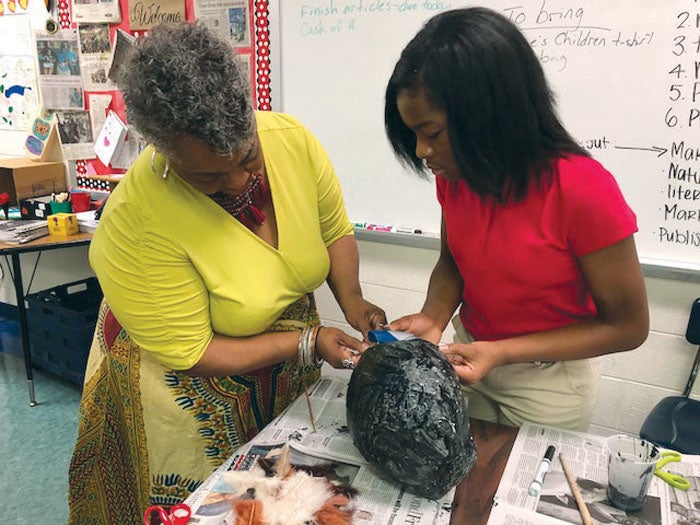Students make masks to celebrate Black History Month and kindness
Published 12:00 am Thursday, March 1, 2018

- Peggy Barnhart, left, helps Madison Krider, right, design an African-style mask during a Black History Month activity at North Rowan Middle. Submitted photo
By Angelia Fleming’s sixth-grade AIG class
North Rowan Middle School
SPENCER — How does celebrating Black History Month relate to kindness? A sixth-grade class at North Rowan Middle School used a hands-on activity to find out.
We were thrilled to find out that we would get to do something to express our knowledge for Black History Month by making traditional African masks. Our teacher, Angelia Fleming, contacted Peggy Barnhart, author of “Season of Light,” for help. Barnhardt offered to lead us in an activity to explore African history and to create traditional masks.
As we conducted our research and created our own portrayals of cultural masks, we were also able to incorporate kindness and students’ personalities into our artwork as well.
We prepared the whole week for this. We collected our materials and then started off by making paper mache-covered balloons. It was messy. We got our hands covered in the paste, but it was so much fun.
As we let them dry throughout the week, we were a little worried; it was a cloudy and dreary week. Would they dry in time?
We researched different facts about Africa and the symbolism of the masks that we were creating.
During the week, we discovered interesting facts about Africa. For example, women and children walk an average of 3.7 miles a day just to get the water they need to survive. There are more people speaking French in Africa than in France. Benin, a country in Africa, has the highest average birth of twins. The Sahara Desert is the largest desert in the world and is bigger than the continental United States. There are more than 1,500 languages spoken in Africa
As the final drew near, we were bubbling with excitement. Then, on Friday, we spread out our supplies including paint, decorations, beads, feathers and more. We used the inspirations from traditional African masks that we found on different sites. Then we painted our base first — most of us using a tan, black or brown shade.
We applied our decorations with tacky glue and added the colorful paint. If we wanted to add glitter, we had to wait until the mask was dry, add another layer of paint and then glitter onto the wet paint.
“What I liked about the masks was how we could use inspiration for our masks from other people, but we made them our own, and we could make them unique and colorful,” student Ella Jones said.
Since two masks could be made out of each paper mache balloon, we decided to make our second mask a kindness interpretation. The kindness side represented our individuality and how we could express kindness to everyone.
“I liked how we could create a different mask than someone else’s and it’s OK. You don’t have to make the same exact one. This exemplifies our kindness challenge — we are all different, but we can appreciate each other,” student Luke Hicks said.
This is our challenge to everyone: What if we all take off our masks and accept each other’s differences to create a unified and welcoming culture where individuals are celebrated? Think of the world we could create; will you join our kindness challenge?


